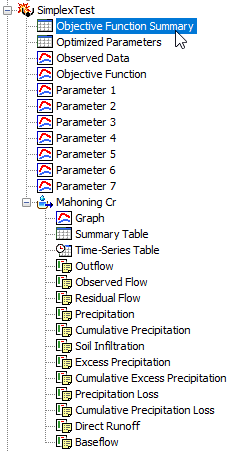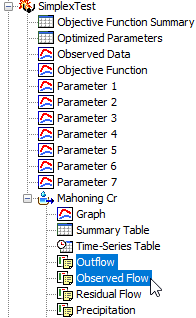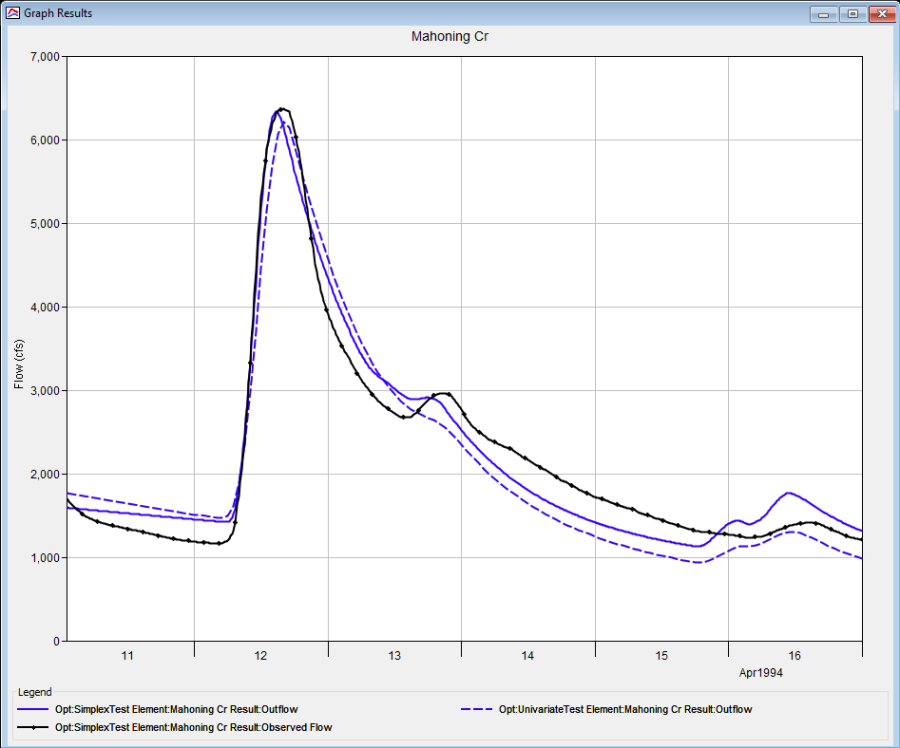Download PDF
Download page Viewing Results for Other Trials.
Viewing Results for Other Trials
In addition to viewing results for the currently selected Optimization Trial, it is also possible to view results for other trials that are not the current selection. However, those other trials are also tracked in the same way as the current trial to make sure data has not changed and results do not need to be recomputed. If any of the data in an Optimization Trial changes, it will have to be recomputed before results can be viewed. Results for other Optimization Trials are accessed from the Watershed Explorer, on the Results tab.
To begin viewing results, go to the Results tab of the Watershed Explorer and click on the desired Optimization Trial icon. If necessary, click on the Optimization Trials folder to expand it and view the Optimization Trials in the project. The Optimization Trial icon will be disabled if any data used in the trial has changed and results need to be recomputed. If any result is open at the time data changes, the affected results will be automatically updated.
Trial Results
The Objective Function Summary can be accessed by clicking on the Objective Function Summary node in the Watershed Explorer. The table will be displayed. It is exactly the same table that can be viewed for the current Optimization Trial. Similarly, the other results for Optimized Parameters, Hydrograph Comparison, Flow Comparison, Flow Residuals, and Objective Function can also be accessed in the same way.

Individual Elements
Each element above the Objective Function Evaluation Location is shown in the Watershed Explorer under the Optimization Trial node. These elements are listed in hydrologic order after the Objective Function Graph. The results for each element are accessed by clicking on its node. The first item listed for each element is the Graph; click on the Graph node to view the result (shown in the previous figure). It is exactly the same graph that can be viewed for the current Optimization Trial. The information included in the graph varies by element type but always includes Outflow. Optional items such as Observed Flow, Computed Stage, and Observed Stage are also included. Similarily, the Summary Table and Time-Series Table can also be accessed by clicking on the Summary Table or Time-Series Table node, respectively.
Element Time-Series Preview Graph
All of the time-series data computed by an individual element are available for viewing. The time-series data are listed under each Element node in the Watershed Explorer. The first node under each element is the Graph, followed by the Summary Table and Time-Series Table. The remaining nodes for each element represent the different time-series data. Click on a Time-Series node to preview the data in the Component Editor. You may select multiple time-series data by holding the shift or control key while using the mouse to click on additional nodes. The selected time-series may come from different elements in the same Optimization Trial, the same element in different trials, or different elements in different trials. Results can also be combined from both Simulation Runs and Optimization Trials. The selected time-series data will automatically be partitioned into groups by data type.

Time-Series Tables and Graphs
Preview graphs of selected time-series data can be opened as Graphs or Time-Series Tables within the Desktop area. Begin by selecting the time-series you wish to include in the graph or table. Once you have selected the desired time-series, you can press the Graph or Time-Series Table buttons on the Toolbar. The chosen time-series will be graphed or tabulated.

After you have opened a Time-Series Table or Graph, you may add Additional Time-Series Results. Position the mouse over the time-series result you wish to add to the graph or table. Press and hold the left mouse button and then drag the mouse over the top of the graph or table where you want the result to be added. The mouse cursor will change to indicate which tables and graphs can accept the additional time-series. Release the mouse button while it is over the desired table or graph and it will be automatically updated to show the additional time-series results.
Changing Graph Properties
All of the graphs open with default properties for Line Color, Line Style, Data Symbols, etc. These default properties have been selected to be appropriate for most situations. However, it is possible to customize the properties in a graph. To change the properties, first click on the Graph to select it. Next go to the Results menu and select the Graph Properties command. An editor will open that can be used to change the properties of the selected graph. The properties for each time-series curve can be changed. It is also possible to change the properties for the Axis, Title, Gridlines, Patterns, and Legend. The editor used to change properties is the same as used for Simulation Run Graphs shown in Viewing Results for Other Runs.